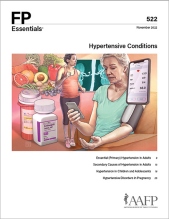
As family physicians, we see patients with hypertension (HTN) in our practice every day. There are 116 million Americans with HTN1 and each year there are more than 500,000 deaths.2 However, more important to me than statistics, are the patients that I am able to keep from being part of these statistics. It is the 35-year-old man who came into the office with a knee injury who we found has prehypertension but with dietary and lifestyle changes was able to lower his blood pressure (BP) and delay the development of HTN. It is the 68-year-old woman with diabetes, HTN, and hyperlipidemia who has not had kidney disease, myocardial infarction, or stroke because she has been monitoring her BP and her HTN has been well controlled with lisinopril and lifestyle.
Section One of this edition discusses screening, diagnosis, and management of essential HTN in adults. Section Two explores secondary causes of HTN, including renovascular disease, renal parenchymal disease, primary hyperaldosteronism, substance-induced HTN, and obstructive sleep apnea. Section Three reviews screening, diagnosis, and management of HTN in children and adolescents. Section Four discusses hypertensive disorders in pregnancy.
While we all know the importance of screening for and managing HTN, it is easy to get distracted by the many clinical and administrative tasks we face each day. I found that this FP Essentials helped to clarify the conflicting guidelines around HTN and was an excellent refresher on the current evidence-based approach to BP management. I hope that you will consider how you can ensure that you are consistently applying guideline-supported HTN screening and management in your practice.
Ryan D. Kauffman, MD, FAAFP, Associate Medical Editor
Founder, Hickory Medical Direct Primary Care
Bellefontaine, Ohio
